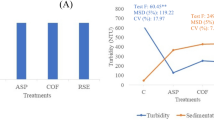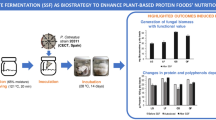Abstract
Dried glasswort was used as a raw material in the nuruk- and makgeolli-making process. The antioxidant, polyphenol, and total phenolic contents extracted from glasswort with 10% ethanol were 953 mM, 2,928 mg/kg, and 214 mg/kg, respectively. Saccharomyces cerevisiae generated 9.7 and 72.4 g/L of ethanol in glucose-defined medium without glasswort and 20 g/L of glasswort, respectively. Nuruk was prepared from rice, wheat, and a rice-glasswort mixture. Approximately 93, 91, and 123 g/L of ethanol was produced in the makgeolli fermented with rice nuruk (RN), wheat nuruk (WN), and rice-glasswort nuruk (RGN), respectively. Antioxidant, polyphenol, and total phenolic contents in the RGN-makgeolli were significantly higher than in the RN- and WN-makgeolli. The Fe, K, and Mg contents of the RGN-makgeolli were relatively higher than those of the RN- and WN-makgeolli. From these results, it may be suggested that the addition of glasswort to the nuruk-making culture enhanced yeast growth and improved nutritional quality of makgeolli.
Similar content being viewed by others
References
Min JG, Lee DS, Kim TJ, Park JH, Cho TY, Park DI. Chemical composition of Salicornia herbacea L. Korean J. Food. Sci. Nutr 7: 105–107 (2002)
Shimizu K. Effect of salt treatments on the production and chemical composition of glasswort (Salicornia herbacea L.), rhodesgrass, and alfalfa. Jpn. J. Trop. Agr. 44: 61–67 (2000)
Jo YC, Ahn JH, Chon SM, Lee KS, Bae TJ, Kim DS. Studies on pharmacological effects of glasswort (Salicornia herbacea L.). Korean J. Med. Crop Sci. 10: 93–99 (2002)
Han SK, Kim SM, Pyo BS. Antioxidative effect of glasswort (Salicornia herbacea L.) on the lipid oxidation of pork. Korean J. Food Sci. Anim. Resour. 23: 46–49 (2003)
Lee JT, Jeong YS, An BJ. Physiological activity of Salicornia herbacea L. and its application for cosmetic materials. Korean J. Herbol. 17: 51–60 (2002)
Shon SK, Rho YH, Kim HJ, Bae SM. Takju brewing of uncooked rice starch using Rhizophus koji. Korean J. Appl. Microbiol. Biotechnol. 18: 506–510 (1990)
Yu Ts, Yeo SH, Kim HS. A new species of hypomycetes, Aspergillus coreanus sp. nov., isolated from traditional Korean nuruk. J. Microbiol. Biotechn. 14: 182–187 (2004)
Lee SJ, Bae HJ, Ryu J, Lee D, Kim GW, Baek N, Kwon M, Hong S. Extracts from Rhizopus oryzae KSD-815 of Korean traditional nuruk confer the potential to inhibit hypertension, platelet aggregation, and cancer metastasis in vitro. Food J. Sci Biotechnol. 18: 1423–1429 (2009)
Jeon BY, Kim SJ, Kim DH, Na BK, Park DH, Tran HT, Zhang R, Ahn DH. Development of a serial bioreactor system for direct ethanol production from starch using Aspergillus niger and Saccharomyces cerevisiae. Biotechnol. Bioprocess Eng. 12: 566–537 (2007)
Rural Resources Development Institute. Food Composition Table. 7th ed. (2006). Available from: http://koreanfood.rda.go.kr/fct/FctFoodSrch.aspx. Accessed Feb. 24, 2010.
Kim HR, Kwon YH, Jo SJ, Kim JH, Ahn BH. Characterization and volatile flavor components in glutinous rice wines prepared with different yeasts of nuruks. Korean J. Food Sci. Technol. 41: 296–301 (2009)
Hong Y, Choi EH. Flavor and sensory characteristics of soju fermented by the co-culture of isolates from nuruk and brewing mashes. Food Sci. Biotechnol 11: 700–703 (2002)
Lee JS, Lee TS, Park SO, Noh BS. Flavor components in mash of takju prepared by different raw materials. Korea J. Food Sci. Technol. 28: 316–323 (1996)
Yu TS, Kim HS, Hong J, Ha HP, Kim TY, Yoon IW. Bibliographical study on microorganisms of nuruk (until 1945). J. Korean Soc. Food Nutr. 25:170–179 (1996)
Price ML, Butler LG. Rapid visual estimation and spectrophotometric determination of tannic content of sorghum grain. J. Agr. Food Chem. 25: 1268–1273 (1977)
Al-Numair KS, Ahmed SEB, Al-Assaf AH, Alamri MS. Hydrochloric acid extractable minerals and phytate and polyphenols contents of sprouted faba and white bean cultivars. Food Chem. 113: 997–1002 (2009)
Jayaprakasha GK, Singh RP, Sakariah KK. Antioxidant activity of grape seed (Vitis vinifera) extracts on peroxidation models in vitro. Food. Chem. 73: 285–290 (2001)
Lusarczyk S, Hajnos M, Skalicka-WoŸniak K, Matkowski A. Antioxidant activity of polyphenols from Lycopus lucidus Turcz. Food Chem. 113: 134–138 (2009)
Lee YJ, Lee KH, Ahn CB, Chun SS, Je JY. Antioxidant and acetylcholine esterase inhibition activity of mulberry fruit extracts. Food Sci. Biotechnol. 18: 1532–1536 (2009)
Je JY, Ahn CB, Oh MJ, Kang SY. Antioxidant activity of a red seaweed Polysiphonia morrowii extract. Food Sci. Biotechnol. 18: 124–129 (2009)
Lim TS, Do JR, Kwon JH, Kim HK. Physiological activities of Rheum undulatum and Rheum palmatum extracts as affected by solvents. Food Sci. Biotechnol. 18: 43–47 (2009)
Park SM, Lee SC. Effect of hydrothermal treatment on the antioxidant activity of rice hull extracts. Food Sci. Biotechnol. 18: 1435–1438 (2009)
Zha, XQ, Luo JP, Zhang L, Hao J. Antioxidant properties of different polysaccharides extracted with water and sodium hydroxide from rice bran. Food Sci. Biotechnol. 18: 449–455 (2009)
John GB, Archer TE. Nutrient requirements for growth of the sherry flor yeast Sacchromyces beticus. Appl. Environ. Microb. 5: 56–60 (1957)
Ranzi BM, Compagno C, Martegani E. Analysis of protein and cell volume distribution in glucose-limited continuous cultures of budding yeast. Biotechnol. Bioeng. 28: 185–190 (1986)
Kwon DJ, Kim WJ. Isolation of higher alcohol-producing yeast as the flavor components and determination of optimal culture conditions. Food Sci. Biotechnol. 14: 576–580 (2005)
Ryu DS, Kim SH, Lee DS. Immunomodulating activity of Salicornia herbacea extract. Korean J. Microbiol. Biotechnol. 36: 135–141 (2008).
Yi DY, Kim GM, Lee KY, Lee CH. Organic acid composition and flavor characteristics of lactic acid fermented cereal beverage. J. Microbiol. Biotechn. 3: 129–133 (1993)
Nielsen JC, Richelieu M. Control of flavor development in wine during and after malolactic fermentation by Oenococcus oeni. Appl. Environ. Microb. 65: 740–745 (1999)
Urbach G. Contribution of lactic acid bacteria to flavor compound formation in dairy products. Int. Dairy J. 5: 877–903 (1995)
Seo DH, Jung JH, Kim HY, Kim YR, Ha SJ, Kim YC, Park CS. Identification of lactic acid bacteria involved in traditional Korean rice wine fermentation. Food Sci. Biotechnol. 6: 994–998 (2007)
Author information
Authors and Affiliations
Corresponding author
Rights and permissions
About this article
Cite this article
Jeon, B.Y., Seo, H.N., Yun, A. et al. Effect of glasswort (Salicornia herbacea L.) on nuruk-making process and makgeolli quality. Food Sci Biotechnol 19, 999–1004 (2010). https://doi.org/10.1007/s10068-010-0140-9
Received:
Revised:
Accepted:
Published:
Issue Date:
DOI: https://doi.org/10.1007/s10068-010-0140-9




